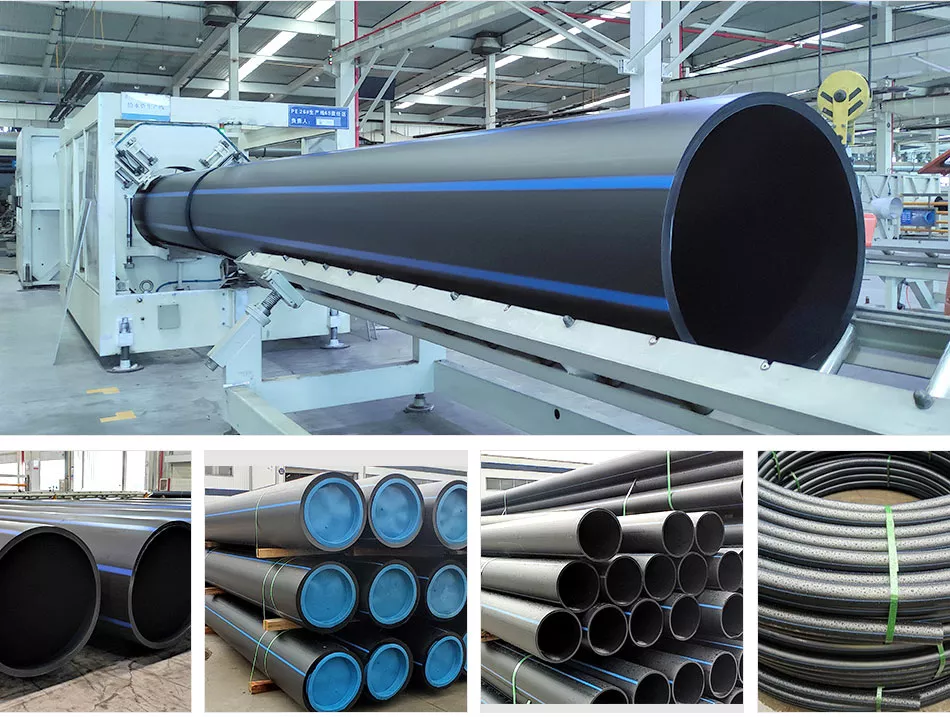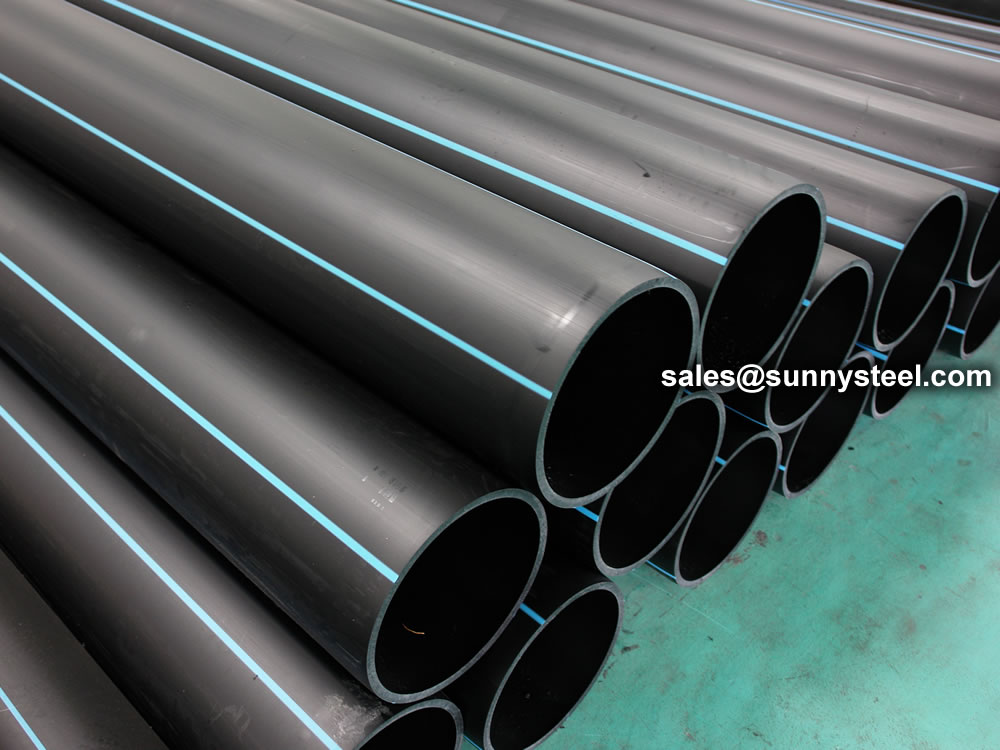Where to Source Midland TX HDPE Pipe Fittings in Stock for Fast Installation
Discover the Manufacturing Process Behind High-Quality HDPE Pipeline and Its Applications
The manufacturing procedure of premium HDPE pipelines is complex and systematic. It starts with the choice of resources that enhance performance. Following this, ethylene undertakes polymerization to create resin, which is then formed via extrusion. Quality assurance is paramount, guaranteeing that the end product meets stringent criteria. Nonetheless, the journey of HDPE pipes does not end with manufacturing. Their applications across numerous industries expose a broader value worth taking a look at.
Understanding HDPE: Residences and Advantages

High-density polyethylene (HDPE) is a functional thermoplastic recognized for its longevity and resistance to various ecological variables. This product exhibits outstanding tensile strength, making it ideal for requiring applications. Its low-density structure adds to a light-weight product, helping with convenience of handling and setup. HDPE likewise showcases exceptional resistance to chemicals, which decreases destruction when subjected to harsh compounds.
The material's reduced dampness absorption even more enhances its longevity, making it optimal for use in pipelines and storage space tanks. Furthermore, HDPE is resistant to ultraviolet (UV) radiation, ensuring that items preserve their stability even when exposed to sunlight. Additionally, its versatility enables for the development of intricate forms without compromising toughness. The green nature of HDPE, often derived from recycled materials, adds to its allure, advertising lasting practices in production. On the whole, these residential properties and benefits make HDPE a preferred choice for different commercial and consumer applications.
Basic Material Selection for HDPE Manufacturing
The choice of resources for HDPE manufacturing is necessary to validate the end product satisfies the desired specs and top quality requirements. High-density polyethylene (HDPE) is primarily created from polymerized ethylene, stemmed from nonrenewable fuel sources such as all-natural gas or unrefined oil. The high quality of these feedstocks significantly affects the mechanical and thermal properties of the final HDPE.
Additives likewise play a significant role in enhancing HDPE's efficiency, including antioxidants, UV stabilizers, and colorants, which enhance resilience and resistance to ecological aspects. The option procedure have to take into consideration not just the chemical composition of the raw products however additionally their handling attributes to guarantee effective manufacturing.
The sourcing of raw materials should prioritize sustainability and conformity with environmental regulations, as liable practices are imperative in today's market. Eventually, mindful raw product option lays the foundation for generating top notch HDPE pipelines ideal for varied applications.
The Extrusion Refine: Shaping HDPE Pipeline
The extrusion process plays a crucial duty fit HDPE pipes, beginning with precise material prep work techniques that guarantee optimal flow and consistency. Equally vital is the layout of the die, which straight affects the last dimensions and surface quality of the pipeline. With each other, these variables add greatly to the efficiency and quality of HDPE pipe manufacturing.
Material Prep Work Techniques
Efficient production of HDPE pipelines starts with meticulous product prep work strategies, especially the extrusion procedure. During this phase, high-density polyethylene resin is initial dried to remove wetness, making sure optimal circulation qualities. The material is after that fed right into the extruder, where it goes through heating and melting, changing right into a viscous state. This home heating process is meticulously regulated to keep the material's stability and efficiency. The molten HDPE is compelled via a die, shaping it right into a continual pipeline form. Correct temperature monitoring during extrusion is crucial, as it straight influences the product's residential or commercial properties and the end product high quality. As soon as formed, the HDPE pipe is cooled down and cut to specified sizes, ready for subsequent handling and applications.
Die Style Relevance
Precision in die layout plays a necessary function in the extrusion procedure of HDPE pipelines. The die serves as the final shaping device, straight influencing the pipeline's dimensions, wall surface thickness, and surface coating. A properly designed die warranties uniform product circulation, lowering problems such as abnormalities and vulnerable points. The geometry of the die have to be enhanced to accommodate the particular properties of HDPE, including its viscosity and thermal habits throughout extrusion. Additionally, the cooling rate of the product as it passes through the die can considerably impact the pipeline's architectural honesty. Subsequently, buying innovative die modern technology is crucial for producers intending to create top notch HDPE pipes that fulfill market requirements and client assumptions.
High Quality Control Steps in HDPE Manufacturing
Various variables affect the top quality of HDPE pipeline production, efficient high quality control steps are crucial to assure consistency and dependability in read the final product (American Plastics HDPE Pipe Manufacturing). Key quality assurance techniques include rigorous product evaluation, validating that the raw polyethylene meets established requirements for purity and thickness. Throughout the extrusion read this procedure, criteria such as temperature level, pressure, and cooling time are closely kept an eye on to keep dimensional accuracy and structural integrity
On top of that, post-production screening is important; manufacturers commonly conduct hydrostatic tests to examine the pipe's toughness and resistance to pressure. Aesthetic evaluations for surface flaws better improve quality control. Certification from appropriate standards organizations, like ASTM or ISO, supplies an added layer of reliability. By implementing these thorough high quality control actions, makers can lessen issues, boost efficiency, and make sure that the HDPE pipelines meet the certain demands of numerous applications, ultimately leading to client fulfillment and count on the product.
Applications of HDPE Pipe Throughout Industries
HDPE pipelines are made use of throughout various markets due to their toughness and versatility. In water circulation systems, they guarantee efficient shipment, while in wastewater monitoring, they offer reputable solutions for waste transportation. Additionally, agricultural irrigation networks gain from HDPE's resistance to rust and flexibility, making it an ideal choice for contemporary farming methods.

Water Circulation Equipments
A significant number of industries depend on high-density polyethylene (HDPE) pipes for efficient water distribution systems. Understood for their sturdiness and resistance to rust, HDPE pipes are commonly made use of in local water networks, farming irrigation, and industrial applications. Their lightweight nature promotes easy handling and setup, decreasing labor costs and time. Additionally, HDPE pipes can accommodate different pressure levels, making them ideal for both low and high-pressure systems. hdpe pipe fittings Midland TX. The versatility of the product permits for seamless integration right into existing framework, minimizing the requirement for substantial excavation. HDPE's resistance to chemical seeping assurances that the water delivered stays risk-free and clean, making it an optimal option for maintaining the quality of safe and clean water throughout different markets.
Wastewater Monitoring Solutions
Effective water distribution systems also lead the way for ingenious wastewater monitoring remedies, where high-density polyethylene (HDPE) pipelines play a considerable function. Distinguished for their durability and resistance to corrosion, HDPE pipes are ideal for delivering wastewater in various setups. Their adaptability enables easy setup in complex settings, minimizing the demand for substantial excavation. In addition, HDPE's smooth indoor surface area lowers friction, boosting circulation rates and performance. These pipelines are additionally resistant to chemical leaching, guaranteeing that impurities do not endanger the surrounding environment. Industries, districts, and therapy centers significantly rely upon HDPE pipes for their integrity and longevity, making them a favored option for modern wastewater management systems. This flexibility underscores the critical relevance of HDPE pipes throughout various applications.
Agricultural Watering Networks
Agricultural irrigation networks benefit significantly from the usage of high-density polyethylene (HDPE) pipelines, which provide efficient and reputable water delivery to crops. HDPE pipes are lightweight, making them very easy to transport and set up, while their versatility enables numerous setups in diverse terrains. These pipes show exceptional resistance to deterioration, chemicals, and UV radiation, making certain sturdiness in rough agricultural atmospheres. Furthermore, their smooth interior surface decreases friction loss, optimizing water flow and decreasing power prices related to pumping. The longevity of HDPE pipes, commonly exceeding half a century, adds to lower maintenance and replacement expenses. Subsequently, farmers progressively rely upon Resources HDPE pipelines to improve watering performance and advertise lasting agricultural methods, inevitably causing improved crop returns and resource preservation.
Future Trends in HDPE Pipe Modern Technology
As the need for sustainable and efficient framework grows, developments in HDPE pipeline innovation are positioned to change numerous markets. Emerging patterns include the integration of clever technologies, such as sensors and IoT capabilities, which help with real-time monitoring of pipe problems, lowering maintenance expenses and preventing leaks. Additionally, the development of innovative production methods, such as 3D printing, is making it possible for the production of complicated, tailored pipeline styles that satisfy certain job needs.
The focus on recycling and circular economic situation techniques is driving the advancement of HDPE pipes made from recycled products, enhancing sustainability. Boosted jointing methods, such as electro-fusion and mechanical fittings, are additionally enhancing setup effectiveness and reliability. Lastly, the expanding focus on environmental regulations is pressing suppliers to take on greener manufacturing procedures, making certain that HDPE pipelines not only satisfy industry standards but likewise cultivate a more lasting future for facilities growth.
Often Asked Inquiries
How Does HDPE Compare to Various Other Plastic Materials?
HDPE exceeds numerous various other plastic materials relating to sturdiness, chemical resistance, and adaptability. Its low thickness and high tensile toughness make it perfect for various applications, commonly exceeding choices in both efficiency and longevity.
What Are the Environmental Effects of HDPE Production?
The environmental influences of HDPE manufacturing consist of greenhouse gas exhausts, energy usage, and prospective pollution from manufacturing processes. In addition, improper disposal can result in soil and water contamination, increasing problems about long-lasting ecological results.
Can HDPE Water Lines Be Reused?
Yes, HDPE pipelines can be reused. Numerous centers approve utilized HDPE for handling, transforming it right into brand-new products. This reusing adds to sustainability efforts, minimizing plastic waste while preserving sources and energy in the manufacturing cycle.
What Is the Lifespan of HDPE Pipeline?

Just How Do Temperature Variants Impact HDPE Pipe Efficiency?
Temperature level variations greatly impact HDPE pipeline efficiency, influencing flexibility and strength. Heats can bring about softening, while reduced temperature levels might create brittleness, inevitably influencing the pipe's durability and viability for various applications in diverse settings.